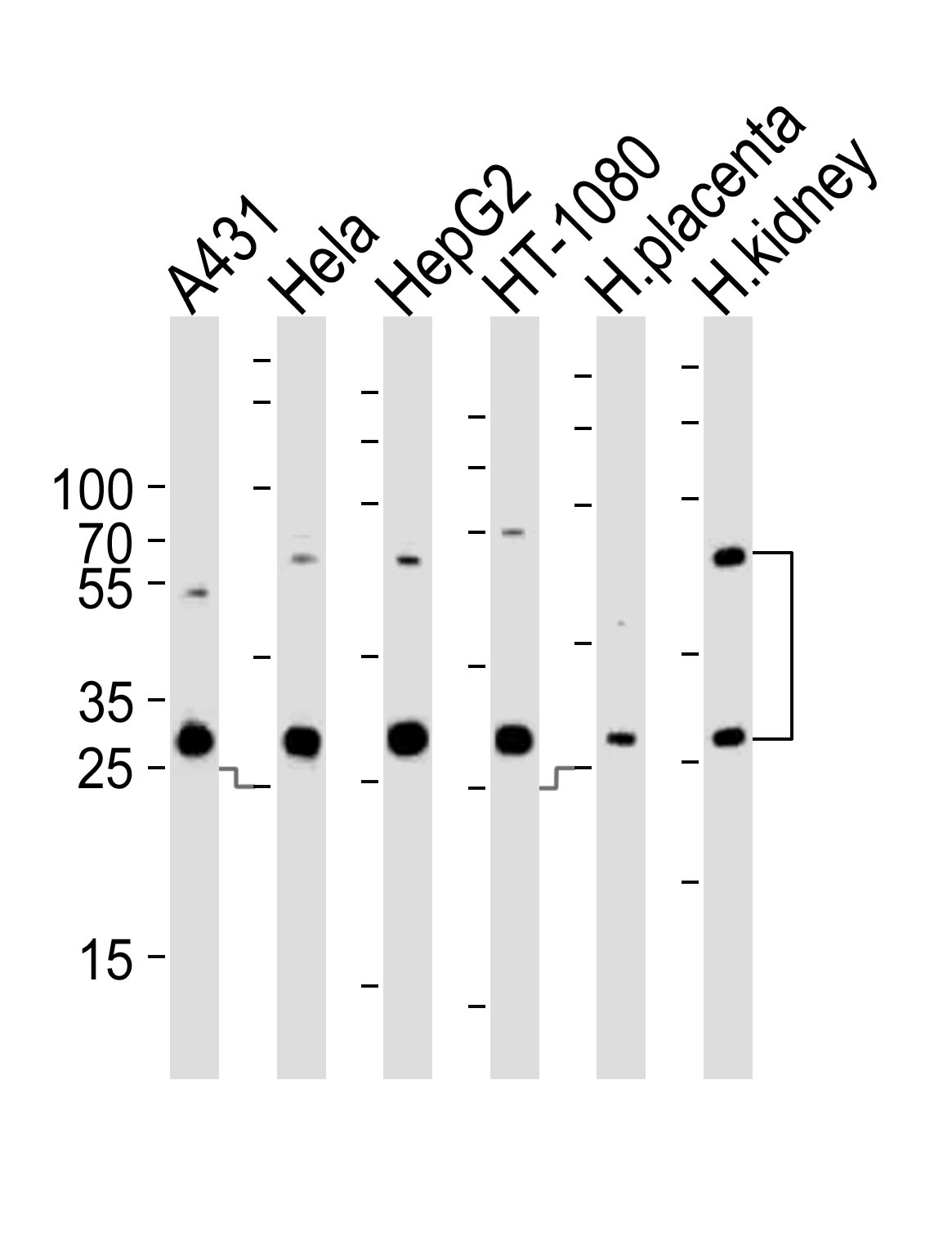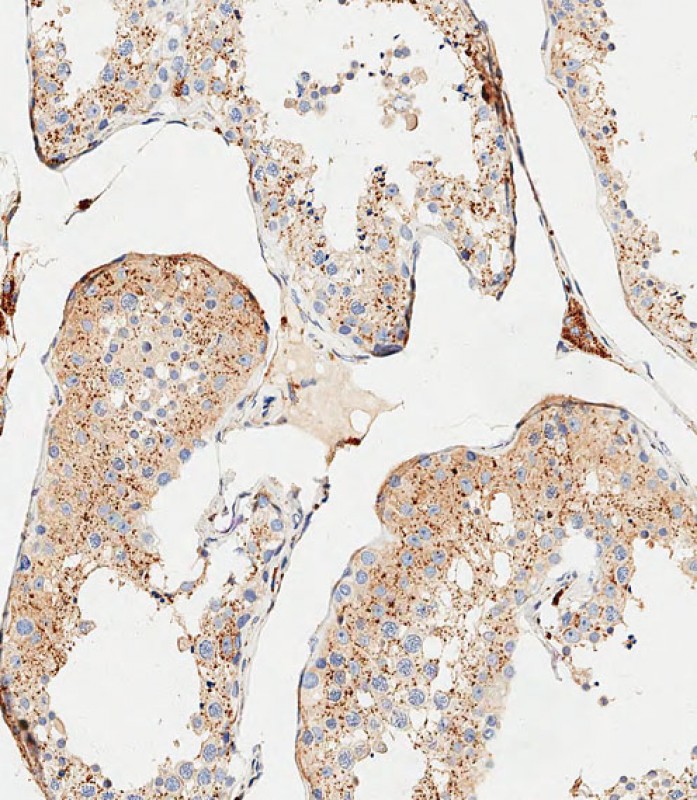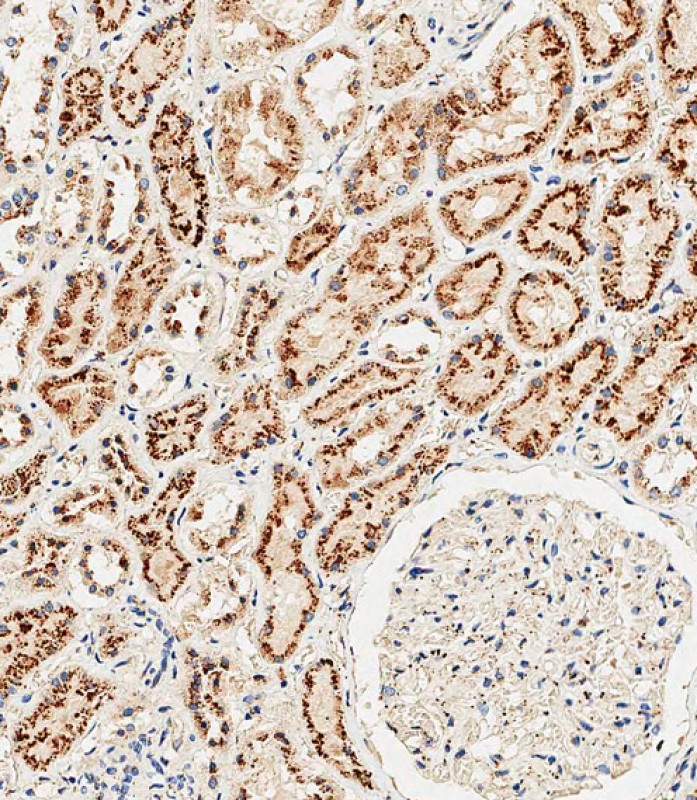CTSA Antibody (N-term)
Affinity Purified Rabbit Polyclonal Antibody (Pab)
- SPECIFICATION
- CITATIONS: 1
- PROTOCOLS
- BACKGROUND

Application
| IHC-P-Leica, WB, E |
|---|---|
| Primary Accession | P10619 |
| Other Accession | NP_001161066.1, NP_000299.2, NP_001121167.1 |
| Reactivity | Human, Mouse |
| Host | Rabbit |
| Clonality | Polyclonal |
| Isotype | Rabbit IgG |
| Calculated MW | 54466 Da |
| Antigen Region | 18-45 aa |
| Gene ID | 5476 |
|---|---|
| Other Names | Lysosomal protective protein, Carboxypeptidase C, Carboxypeptidase L, Cathepsin A, Protective protein cathepsin A, PPCA, Protective protein for beta-galactosidase, Lysosomal protective protein 32 kDa chain, Lysosomal protective protein 20 kDa chain, CTSA, PPGB |
| Target/Specificity | This CTSA antibody is generated from rabbits immunized with a KLH conjugated synthetic peptide between 18-45 amino acids from the N-terminal region of human CTSA. |
| Dilution | IHC-P-Leica~~1:500 WB~~1:2000 E~~Use at an assay dependent concentration. |
| Format | Purified polyclonal antibody supplied in PBS with 0.09% (W/V) sodium azide. This antibody is purified through a protein A column, followed by peptide affinity purification. |
| Storage | Maintain refrigerated at 2-8°C for up to 2 weeks. For long term storage store at -20°C in small aliquots to prevent freeze-thaw cycles. |
| Precautions | CTSA Antibody (N-term) is for research use only and not for use in diagnostic or therapeutic procedures. |
| Name | CTSA |
|---|---|
| Synonyms | PPGB |
| Function | Protective protein appears to be essential for both the activity of beta-galactosidase and neuraminidase, it associates with these enzymes and exerts a protective function necessary for their stability and activity. This protein is also a carboxypeptidase and can deamidate tachykinins. |
| Cellular Location | Lysosome. |

Provided below are standard protocols that you may find useful for product applications.
Background
CTSA encodes a glycoprotein which associates with lysosomal enzymes beta-galactosidase and neuraminidase to form a complex of high molecular weight multimers. The formation of this complex provides a protective role for stability and activity. Deficiencies in this gene are linked to multiple forms of galactosialidosis.
References
Reich, M., et al. Immunol. Lett. 128(2):143-147(2010)
Bonten, E.J., et al. J. Biol. Chem. 284(41):28430-28441(2009)
Ewing, R.M., et al. Mol. Syst. Biol. 3, 89 (2007) :
Tatano, Y., et al. J. Med. Invest. 53 (1-2), 103-112 (2006) :
Lewandrowski, U., et al. Mol. Cell Proteomics 5(2):226-233(2006)
If you have used an Abcepta product and would like to share how it has performed, please click on the "Submit Review" button and provide the requested information. Our staff will examine and post your review and contact you if needed.
If you have any additional inquiries please email technical services at tech@abcepta.com.














 Foundational characteristics of cancer include proliferation, angiogenesis, migration, evasion of apoptosis, and cellular immortality. Find key markers for these cellular processes and antibodies to detect them.
Foundational characteristics of cancer include proliferation, angiogenesis, migration, evasion of apoptosis, and cellular immortality. Find key markers for these cellular processes and antibodies to detect them. The SUMOplot™ Analysis Program predicts and scores sumoylation sites in your protein. SUMOylation is a post-translational modification involved in various cellular processes, such as nuclear-cytosolic transport, transcriptional regulation, apoptosis, protein stability, response to stress, and progression through the cell cycle.
The SUMOplot™ Analysis Program predicts and scores sumoylation sites in your protein. SUMOylation is a post-translational modification involved in various cellular processes, such as nuclear-cytosolic transport, transcriptional regulation, apoptosis, protein stability, response to stress, and progression through the cell cycle. The Autophagy Receptor Motif Plotter predicts and scores autophagy receptor binding sites in your protein. Identifying proteins connected to this pathway is critical to understanding the role of autophagy in physiological as well as pathological processes such as development, differentiation, neurodegenerative diseases, stress, infection, and cancer.
The Autophagy Receptor Motif Plotter predicts and scores autophagy receptor binding sites in your protein. Identifying proteins connected to this pathway is critical to understanding the role of autophagy in physiological as well as pathological processes such as development, differentiation, neurodegenerative diseases, stress, infection, and cancer.






